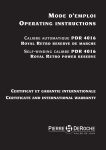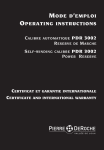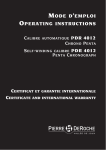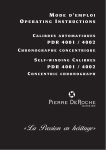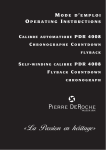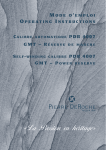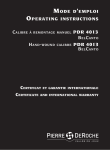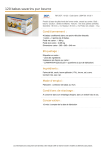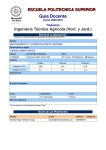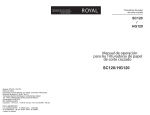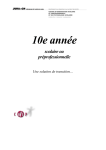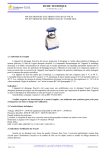Download Mode d`eMploi operating instructions
Transcript
M ode O perating d ’ emploi instructions C alibre automatique PDR 4018 R oyal R etro GMT ½ heure S elf - winding calibre PDR 4018 R oyal R etro GMT ½ hour Certificat Certificate et garantie internationale and international warranty VALLÉE DE JOUX Table des matières / Table of contents Français Données techniques, fonctions, légende, manipulations 1-2 Mise en marche, réglages, remarques, entretien 3-4 Renseignements divers: •Glossaire 5-6 • Métaux précieux 7 •Poinçons 8 English Technical specifications, descriptions, caption Setting the time, making adjustments, maintenance 9-10 11-12 Additional information: • Glossary 13-14 • Precious metals 15 • Marking requirements 16 Français / English Origine, garantie / Origin, warranty 17-18 Certificat / Certificate 19-20 Signatures / Signatures 21 Calibre automatique PDR 4018 Self-winding calibre PDR 4018 Français Données techniques du mouvement • • • • • • • Mouvement : Dubois Dépraz, calibre 15115 Diamètre : 36.60 mm Hauteur : 6.85 mm Fréquence : 4 Hz (28’800 alternances/h) Empierrage : 48 rubis Réserve de marche : 42 heures Masse oscillante : support en laiton sur roulement à billes. Segment périphérique en métal lourd Fonctions du mouvement Le calibre PDR 4018 comprend les fonctions et spécificités suivantes : •Heures •Minutes • Secondes, au moyen de 4 aiguilles rétrogrades parcourant 10 secondes chacune. Dans la zone allant de 20 à 40, l’affichage est interrompu mais le cycle se poursuit ; ce sont 20 secondes mystérieuses. En définitive, seules 4 aiguilles suffisent à l’affichage du cycle complet de 60 secondes •Quantième • Affichage d’un second fuseau horaire (GMT), ajustable par sauts successifs de ½ heure en ½ heure Par ailleurs ce calibre est aussi équipé d’un mécanisme dit de « tige réhaussée », lequel permet de positionner idéalement la couronne de remontoir au niveau de la boîte, facilitant les manipulations et améliorant le confort de la montre au porté. 1 Légende A-B-C. Couronne de remontoir vissée (3 positions) 1. Aiguille des heures 2. Aiguille des minutes 3. Aiguilles des secondes (4 x) 4. Aiguille jour/nuit (24 h.) du second fuseau horaire (GMT) 5. Aiguille des heures du GMT 6. Aiguille des minutes du GMT 7. Guichet de quantième 8. Indicateur de l'aiguille rétrograde en fonction Manipulations Couronne (vissée) / Tige de remontoir • Position A: Couronne dévissée, tige de remontoir repoussée à fond; remontage de la montre par rotation de la couronne dans le sens horaire. • Position B: Tige en position intermédiaire : • correction rapide du quantième par rotation de la couronne dans le sens anti-horaire • ajustage du GMT par rotation de la couronne dans le sens horaire. • Position C: Tige tirée complètement; stop seconde (arrêt du mouvement) et mise à l’heure (heures, minutes) par rotation de la couronne dans les 2 sens. 2 Mise en marche et réglages 1. Dévisser la couronne de remontoir en la tournant dans le sens anti-horaire. 2. Remonter la montre manuellement par la couronne en position «A» ; tourner la couronne dans le sens horaire environ 30 tours. Par la suite, la montre se remontera automatiquement par les mouvements du poignet. 3. Tirer la tige de remontoir en position «C» (arrêt mouvement) ; tourner la couronne dans le sens anti-horaire jusqu’à ce que la date change et que les aiguilles se trouvent entre 2h00 et 4h00 (du matin). 4. Repousser la tige de remontoir en position «B» ; effectuer la correction rapide du quantième par rotation de la couronne dans le sens anti-horaire, jusqu’à ce que la date désirée apparaisse dans le guichet. 5. Tirer à nouveau la tige de remontoir en position «C» ; tourner la couronne dans le sens souhaité, jusqu’à l’indication de l’heure désirée. 6. Repousser la tige de remontoir en position « B » et synchroniser l’heure affichée par le GMT à la même heure que celle de l’affichage principal. 7. Lors d’un déplacement dans une région géographique avec un décalage horaire par rapport au pays de résidence, couronne dévissée, placer la couronne en position « B ». Afficher l’heure du pays de destination en tournant la couronne dans le sens horaire. L’heure du second fuseau horaire s’ajuste par sauts successifs de ½ heure en ½ heure, sans arrêt du mouvement. 8. Repousser la tige de remontoir en position «A». Exercer une légère pression sur la couronne en direction de la boîte et revisser la couronne en la tournant dans le sens horaire. 3 Remarques 1. En correction rapide du quantième, il est nécessaire d’effectuer encore un ½ tour supplémentaire de la couronne lorsque la date souhaitée apparaît dans le guichet. Cette opération assure un engrenage correct et le saut du quantième au minuit suivant. 2. La correction rapide du quantième n’est pas recommandée entre 20h00 et 1h00 du matin. Si toutefois le porteur décide de corriger la date, à 22h00 par exemple, elle ne sautera pas à minuit, mais seulement 24 heures plus tard. 3. Pour toute mise à l’heure effectuée dans le sens anti-horaire en passant par minuit, le porteur doit amener ses aiguilles au moins jusqu’à 20h30; dans ce cas de figure, la date ne revient pas au jour précédent. La montre pourra ensuite être réglée sur 22h00 par exemple. Si cette opération est réalisée de la sorte, la date ne sautera pas non plus à minuit. Entretien Pour que votre montre vous donne entière satisfaction, nous recommandons : • D’effectuer les manipulations d’usage conformément au mode d’emploi • De procéder à un contrôle d’étanchéité tous les 2 à 4 ans. • De confier à Pierre DeRoche, respectivement à un horloger agréé par la marque, un service d’entretien complet tous les 4 à 6 ans 4 Glossaire Rétrograde Un affichage rétrograde se caractérise par une aiguille décrivant un arc de cercle (au lieu de pivoter autour d’un axe) et revenant instantanément à sa position initiale une fois arrivée en fin de course, pour entamer un nouveau cycle. GMT La dénomination GMT signifie « Greenwich Mean Time » et fait référence au temps solaire moyen au méridien de Greenwich, méridien d’origine des longitudes traversant l’observatoire royal près de Londres. Le «Greenwich Mean Time» a servi de référence temporelle jusqu’en 1972, année au cours de laquelle il a été remplacé par le temps universel coordonné UTC (Universal Time Coordinated). Malgré cette nouvelle référenciation, la mention GMT est encore couramment employée. Historiquement, la surface terrestre avait été divisée en 24 fuseaux horaires de même taille, où l’heure était identique en tout point. La ligne de changement de date avait été fixée au méridien 180°. Cette subdivision a été ensuite modifiée pour tenir compte des désirs de certains pays qui souhaitaient, par exemple, n’avoir qu’une seule heure légale malgré le fait que leur territoire s’étend sur plusieurs fuseaux (ex: Chine) ou que leur heure légale soit différente que celle qui lui était destinée à priori (ex: Espagne). Par ailleurs, certains pays ont adopté une heure légale correspondant à des fractions (30 et 45 minutes) de fuseau horaire. En finalité il existe aujourd’hui 41 fuseaux horaires, en tenant compte de certains fuseaux qui n’existent que temporairement (heure d’été et/ou d’hiver, hémisphère sud et/ou nord). Parmi eux, 36 sont en vigueur toute l’année. 5 Le choix de la ligne marquant le changement de date correspond approximativement au méridien 180°. Ce méridien, situé dans l’Océan Pacifique, a la particularité de ne toucher pratiquement aucune terre. La ligne a cependant été déviée à 2 endroits pour contourner des îles. Fuseaux horaires fractionnés Les régions et pays suivants sont concernés par une fraction d’une 1/2 heure de fuseau horaire : • • • • • • • • • • • 6 UTC – 9.30 UTC – 4.30 UTC – 3.30 UTC + 3.30 UTC + 4.30 UTC + 5.30 UTC + 6.30 UTC + 8.30 UTC + 9.30 UTC + 10.30 UTC + 11.30 Iles Marquises (France) Venezuela Labrador et Terre-Neuve (Canada) Iran Afghanistan Inde, Sri Lanka Iles Crocos (Australie), Birmanie Corée du Nord Nouvelle-Galles du Sud (Australie) Nouvelle-Galles du Sud (Australie) Ile Norfolk (Australie) Métaux précieux Les métaux précieux les plus utilisés en horlogerie-bijouterie sont l’or et le platine. L’or a la particularité d’être inaltérable, mais aussi malléable et ductile (étirable sans se rompre). L’or n’est pas utilisés à son état pur (titre 999.9/1000 ou 24 carats), mais allié à d’autre métaux dans le but de diminuer sa malléabilité d’une part et de modifier sa couleur d’autre part. Ainsi les alliages d’or, utilisés en horlogerie-bijouterie, sont constitués à 75% d’or et 25% d’autres métaux. Ces autres métaux sont le cuivre, l’argent et le palladium, dont les proportions varient en fonction de la coloration souhaitée : • Or jaune : 75% or, 16% argent, 9% cuivre • Or rose : 75% or, 5% argent, 20% cuivre • Or gris : 75% or, 4% argent, 4% cuivre, 17% palladium Du point de vue de la terminologie, le terme « or » est réservé aux alliages dont les titres sont de 0.916 (22 carats) et 0.750 (18 carats). Quant au platine, l’alliage utilisé en horlogerie-bijouterie est composé de platine (95%) et de palladium (5%). 7 Les poinçons (selon la réglementation suisse) Chaque ouvrage en métal précieux mis dans le commerce en Suisse doit être muni de plusieurs poinçons, enregistrés auprès de l’Administration Fédérale des Douanes (contrôle des métaux précieux). Poinçon de maître Il s’agit généralement du poinçon de la marque ou du fabriquant du composant (ex : boîte de montre). Il peut s’agir également d’un poinçon de maître collectif, c’està-dire une marque déposée par une association de fabricants. Poinçon de garantie nationale suisse et indication de titre Sur toutes les boîtes de montres notamment en or ou platine, fabriquées en Suisse ou importées, sera apposée le poinçon officiel « tête de saint-bernard », à l’effigie du chien éponyme, à côté de l’indication de titre. Avant le 1.8.1995, d’autres poinçons officiels suisses de garantie étaient apposés. Poinçon de garantie internationale de la Convention de Vienne Cette Convention internationale sur le contrôle et le poinçonnement des ouvrages en métaux précieux réunit 10 pays européens, dont la Suisse. Elle prévoit l’apposition d’un poinçon commun sur les ouvrages en platine et or notamment, en plus des 3 indications sus-décrites. Ce poinçon commun de garantie représente une balance, au centre de laquelle figure le titre du métal concerné (750 pour l’or, 950 pour le platine). 8 English Movement technical specifications • • • • • • • Movement: Dubois Dépraz, calibre 15115 Diameter: 36.60 mm Thickness: 6.85 mm Frequency: 4 Hz (28,800 vibrations/hour) Jewelling: 48 jewels Power reserve: 42 hours Oscillating weight: brass base mounted on ball-bearing mechanism. Heavy metal peripheral segment Movement functions Calibre PDR 4018 drives the following displays: •Hours •Minutes • Seconds (by means of 4 retrograde hands covering 10 seconds each). In the zone running from 20 to 40, the display is interrupted but the cycle continues; these are 20 mysterious seconds. In actual fact, 4 hands are enough to display the complete 60-second cycle •Date • Second time-zone display (GMT) adjustable in successive half-hour jumps Moreover, this movement is also equipped with a “raised windingstem” mechanism serving to ensure optimal positioning of the winding crown on the case, which thereby facilitates handling and enhances wearer comfort. 9 Caption A-B-C. Screw-lock winding-crown (3 positions) 1. Hour hand 2. Minute hand 3. Seconds hands (4 x) 4. Day/night hand (in 24-hour mode) for the second time zone (GMT) 5. GMT hour hand 6. GMT minute hand 7. Date window 8. Retrograde hand operating indicator Handling operations Crown (screw-lock) / Winding-stem • Position A: With the crown unscrewed and the winding-stem pushed in as far as possible, wind the watch by rotating the crown clockwise. • Position B: With the stem in the intermediate position: • perform fast date adjustments by turning the crown counter-clockwise • perform GMT adjustments by turning the crown clockwise • Position C: With the stem pulled out as far as possible, the stop seconds mechanism halts the movement and enables you to set the time (hours, minutes) by rotating the crown in either direction. 10 Setting the time and making adjustments 1. Unscrew the winding-crown by turning it counter-clockwise. 2. Wind the watch manually by making around 30 clockwise turns of the crown in position “A”. The watch will subsequently be automatically rewound by your wrist movements. 3.Pull the winding-stem out to position “C” (the movement stops) and rotate the crown counter-clockwise until the date changes and the hands are between 2 and 4 am. 4. Press the winding-stem back to position “B” and make rapid date adjustments by rotating the crown counter-clockwise until the required date appears in the window. 5. Pull the winding-stem out to position “C” again; turn the crown in the required direction until the correct time is displayed. 6. Push the winding-stem back into position “B” and synchronise the time shown by the GMT function with the main time display. 7. When travelling from a geographical region with a time difference in relation to the country of residence, place the (unscrewed) crown in position “B”. Display the time in the destination country by turning the crown clockwise. The time in the second time zone is adjusted in half-hour jumps without stopping the movement. 8. Press the winding-stem back to position “A”. Push the crown gently towards the case and tighten the crown by rotating it clockwise. 11 Special notes 1. When in fast date-adjustment mode, you need to make an extra half-turn of the crown when the required date appears in the window. This operation ensures correct meshing and the corresponding date jump at the next passage through midnight. 2. Fast date adjustment is not advisable between 8pm and 1am. Nonetheless, if the wearer does decide to correct the date during this time, such as at 10pm, it will not jump at midnight, but only 24 hours later. 3.For any time-setting operation performed in a counterclockwise direction including passing midnight, the wearer must bring the hands to at least 8.30pm; in this case, the date does not return to the previous day. The watch can then be set to 10pm for example. If the operation is done in this way, the date will not jump at midnight either. Maintenance To ensure that your watch gives you complete satisfaction, we recommend: • That you perform the customary handling operations in compliance with the operating instructions • That you have its water resistance tested every 2 to 4 years • That you entrust the watch to Pierre DeRoche, or to a watchmaker approved by the brand, for a complete overhaul every 4 to 6 years 12 Glossary Retrograde A retrograde display is distinguished by a hand moving across the arc of a circle (instead of pivoting around an axis) and which returns instantly to its initial position upon reaching the end of its trajectory in order to begin a new cycle. GMT The abbreviation “GMT” stands for Greenwich Mean Time and refers to mean solar time at the Greenwich meridian crossing the royal observatory near London and which serves as the basis for calculating longitudes. “Greenwich Mean Time” served as a temporal reference until 1972, the year when it was replaced by Universal Time Coordinated (UTC). Despite this new reference, the term GMT is still widely used. Historically speaking, the surface of the globe had been divided into 24 equal-sized time zones, in which the hour was identical throughout each. The dateline had initially been fixed at the 180° meridian. This subdivision was subsequently modified to take account of the needs of certain countries wishing for example to have only one legal time, despite the fact that their territory extends over several time zones (such as China) or that their legal time should be different from that theoretically allocated (e.g. Spain). Moreover, some countries (such as Iran) have adopted a legal time corresponding to 30 and 45-minute fractions of a time zone. By now there are actually 41 time zones, including some that exist only temporarily (Daylight Saving Time or “summer” and/or winter time, southern and/or northern hemisphere); among them 36 are valid year-round. 13 The choice of the dateline corresponds approximately to the 180° meridian, located in the Pacific Ocean and distinguished by the fact that it touches virtually no land. The line has nonetheless been slightly diverted to avoid two islands. Fractional time-zones The following regions and countries have half-hour time zones: • • • • • • • • • • • 14 UTC – 9.30 UTC – 4.30 UTC – 3.30 UTC + 3.30 UTC + 4.30 UTC + 5.30 UTC + 6.30 UTC + 8.30 UTC + 9.30 UTC + 10.30 UTC + 11.30 Marquesas Islands (France) Venezuela Labrador and Terra Nova (Canada) Iran Afghanistan India, Sri Lanka Crocodile Islands (Australia), Myanmar North Korea New South Wales (Australia) New South Wales (Australia) Norfolk Island (Australia) Precious metals The precious metals most used in watchmaking and jewellery are gold and platinum. Gold has the specific property of being entirely stable, as well as malleable and ductile (meaning it can be drawn out with breaking). Gold is not used in its pure state (999.9/1000 or 24-carat standard of fineness), but is instead alloyed with other metals so as to lessen its malleability and to modify its colour. The gold alloys used in watchmaking and jewellery are thus composed of 75% gold and 25% other metals. These other metals are copper, silver and palladium, in proportions varying according to the desired colour. • • • Yellow gold: 75% gold, 16% silver, 9% copper Rose gold: 75% gold, 5% silver, 20% copper White gold: 75% gold, 4% silver, 4% copper, 17% palladium As far as terminology is concerned, the word “gold” is reserved for alloys with standards of fineness corresponding to 0.916 (22 carats) and 0.750 (18 carats). As for platinum, the alloy used in watchmaking and jewellery is composed of platinum (95%) and palladium (5%). 15 Marking requirements (according to the Swiss regulations) All objects in precious metal sold in Switzerland must carry several markings, registered with the Federal Customs Administration (Central Office for Precious Metals Control). Responsibility or maker’s mark This is generally the mark of the brand or of the component manufacturer (e.g. for a watch case). It may also be a joint maker’s mark, meaning a trademark registered by an association of manufacturers. Swiss official hallmark and indication of standard of fineness All watch cases, particularly those in gold or platinum, whether made in Switzerland or imported, must bear the official “head of a St. Bernard dog” hallmark, alongside the indication of the fineness standard. Prior to August 1st 1995, other Swiss official confirmation hallmarks were used. Common Control Mark of the Vienna Convention This international convention on the control and marking of precious metal objects has been signed by 10 European countries, including Switzerland. It provides for placing a common control mark on objects in platinum and gold in particular, as well as the other three above-mentioned indications. This common guarantee hallmark depicts scales, at the centre of which the standard of fineness of the metal in question is specified (750 for gold, 950 for platinum). 16 Origine, garantie et certificat Origin, warranty and certificate Origine Nous garantissons que la montre faisant l’objet du présent certificat est d’origine suisse et qu’elle remplit les critères du « Swiss made » conformément à la réglementation en la matière. Origin We guarantee that the watch to which this certificate applies is of Swiss origin and that it meets the “Swiss made” criteria in compliance with the prevailing regulations. 17 Garantie Nous garantissons la montre faisant l’objet du présent document pour une période de 2 ans, à compter de la date d’achat. La garantie couvre toute défectuosité technique ou vice de fabrication. Les dommages résultant d’un choc ou d’une manipulation erronée de la montre ne sont pas couverts par la garantie. Pour que la garantie soit effective, le timbre, la date et la signature du détaillant auprès duquel la montre a été achetée doit être apposée sur le présent document. Warranty We guarantee the watch to which this document applies for a period of 2 years, as of the date of purchase. The warranty covers any technical flaw or manufacturing defect. Any damage resulting from a shock or from incorrect handling of the watch is not covered by the warranty. In order for the guarantee to be valid, the stamp, date and signature of the retailer where the watch was purchased must appear on the present document. 18 Certificat de la montre Pierre DeRoche Pierre DeRoche watch certificate Référence / Reference Mouvement / Movement (N°) Boîte / Case (N°) Série limitée / Limited Series (N°) Nombre / Number Diamants / Diamonds Taille / Cut Poids / Carat Pureté / Clarity Couleur / Colour Nombre / Number Rubis / Rubies Taille / Cut Poids / Carat Pureté / Clarity Couleur / Colour Nombre / Number Saphirs / Sapphires Taille / Cut Poids / Carat Pureté / Clarity Couleur / Colour Nombre / Number Emeraudes / Emeralds Taille / Cut Poids / Carat Pureté / Clarity Couleur / Colour 19 Certificat de la montre Pierre DeRoche Pierre DeRoche watch certificate Autres pierres / Other stones Or / Gold (750) Poids / Weight Platine / Platinum (950) Poids / Weight Autres Métaux / Other metals 20 Nous vous félicitons d’avoir choisi une montre Pierre DeRoche. Afin de vous garantir une qualité de service de 1er ordre, nous vous invitons à consulter notre site internet. We congratulate you on buying a Pierre DeRoche watch. In order to guarantee you first-rate service, we invite you to consult our website. Tampon et signature Pierre DeRoche / Pierre DeRoche stamp and signature Coordonnées du détaillant Retailer’s contact details Tampon et signature du détaillant / Retailer’s stamp and signature Lieu, date / Place, date: Les différentes rubriques de ce mode d’emploi figurent sur le site internet www.pierrederoche.com The various sections of these operating instructions appear on the brand website www.pierrederoche.com P ierre D e R oche SA Le Revers 1 CH-1345 Le Lieu SWITZERLAND Tel. +41 21 841 11 69 Fax +41 21 841 20 52 www.pierrederoche.com


























